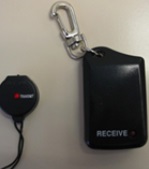Dementia - How to Prevent and Handle the Problem of Getting Lost?
According to a local survey conducted in 2021, it was found that around 30% of people with dementia had the experience of getting lost, which was a slight increase in percentage compared to the results 14 years ago.
The consequences can be fatal. Wandering can put people with dementia in danger as they may experience dehydration and starvation, be exposed to extreme weather conditions, or suffer from traffic accidents or falls. The following strategies may help them reduce the risks of getting lost.
Correct approach to manage wandering
Owing to cognitive decline, people with dementia may become disorientated in environment and direction. They can easily get lost or even lost.
Therefore, many carers choose to apply restraints to restrict their activities and do not allow them to leave home. However, inappropriate use of restraints will jeopardize their relationship with carers without solving the problem. Restraints can also cause further physical and cognitive decline, which may lead to greater confusion and agitation of the people with dementia.
How to prevent people with dementia from getting lost?
To prevent people with dementia from getting lost, carers can adopt the following strategies: Carers need to look into the reasons for their wandering and leaving home. For example, do they need to go to the washroom? Are they hungry, bored or confused in identifying the location? By finding out the underlying causes, carers can devise effective measures to reduce the triggers of wandering. Structured daily routines, environmental design and use of assistive devices are useful strategies to reduce their chance of getting lost and increase the opportunities to find them.
1. Establish structured daily routines
- Minimize any change in the environment and daily routines of demented people to increase their sense of security.
- Involve them in familiar and manageable activities. This helps to prevent them from taking afternoon nap and night-time wandering as well as the intention to go out.
- Accompany them for a walk to provide a healthy outlet of energy and emotions such as ambling with them in the park or shopping mall. Alternatively, choose a safe and enclosed walking path where they can stroll freely.
2. Use appropriate environmental cues and assistive devices
- Use visual cues such as pictures or words to help people with dementia to orientate the environment (Diagram 1).

Diagram 1: Use picture and words to indicate the location of toilet - Paint the doors with the same colour as the walls, or cover them with a cloth to camouflage the exits to make them unable to find their way out. A door chain may be considered but safe escape, in case of emergency has to be ensured.
- Consider to use alarms such as motion-sensitive alarm, bed exit monitor, door sensor or beeping monitor to alert carers when they wander off (Diagram 2).

Diagram 2: Beeping monitor - People with dementia may wear bracelets, necklaces or clothing imprinted with their names and contact information label for easy identification and contact with the carers (Diagram 3).
- Also can utilize the technology by installing “Location Tracking System for Dementia” in smart phone or smart watch in order to trace the location of people with dementia./li>
- Prepare a notice with recent photographs of the patient to facilitate distribution of a “Missing Person Notice” through tracing platforms or social media.
- Carers may also inform neighbours or security guards about this potential problem, so that they can also help to pay attention to the location of the people with dementia.
- Keep recent photographs of the people with dementia to help with identification in case of need.

Diagram 3: Name tag with patient’s name & contact information
Management after getting lost
In fact, it is possible for the people of dementia to get lost. So, we have to pay attention to the following:
- Family members should keep calm.
- Check the “location tracking device” information if tracking system is installed in smart phone or smart watch.
- If client leaves from home, contact the property management office as soon as possible to inquire about the possible whereabouts, such as the details of when and where he/she was last seen or heard from
- Call the police immediately and inform the police with the patient’s distinguished personal characteristics, such as clothing, body shape, and appearance.
- Distribute a “Missing Person Notice” through tracing platforms or social media.
- A relative should stay at home to provide support in case the patient returns home by himself/herself.
- Try to find likely destinations such as old home, former workplace, favourite places or places with past connection
- Inform the public transportation agency about the missing elderly’s “Octopus Number” that you wrote down in advance for assistance.
- If the patient is lost near or inside the MTR station, the staff should be notified so as to prompt a passenger announcement.
Conclusion
To minimize the chance of getting lost, effective communication, understanding their needs, being familiar with their daily habits, and removing the causes of wandering behaviours are crucial. Carers are encouraged to discuss with family members and share the caring duties. Carers may contact healthcare professionals for further advice.
Related Audiovisual and Booklet Package(s):
Practical Tips for Carers - Dementia Care
Practical Tips on the Carers of Elders with Moderate to Severe Dementia - Dementia Care II
